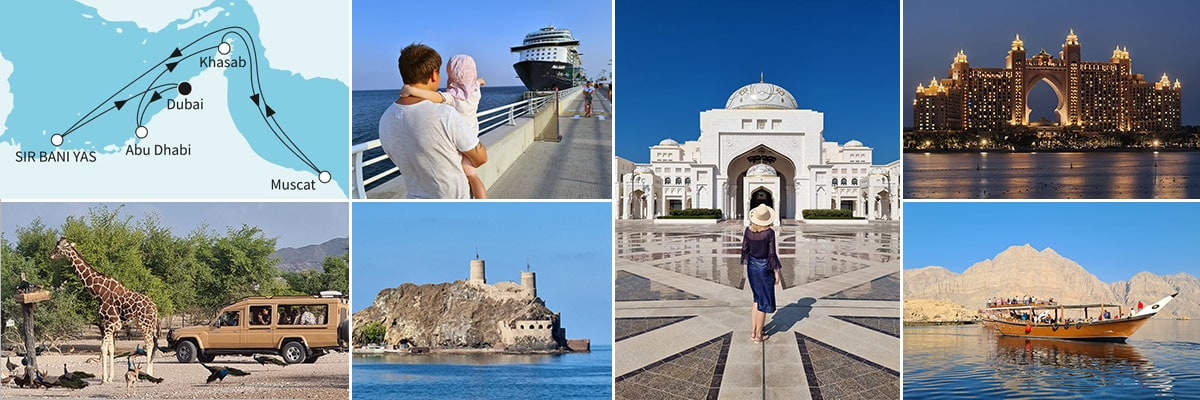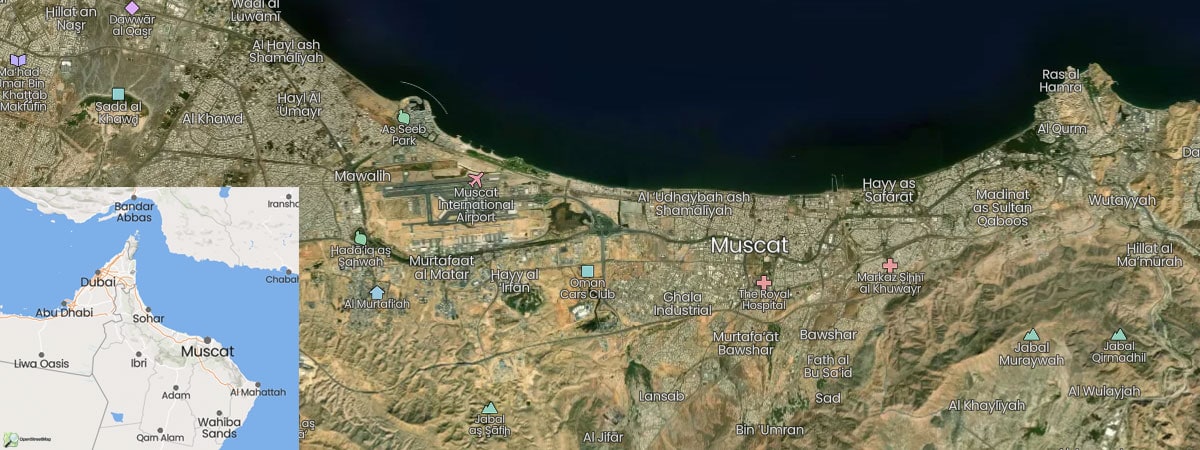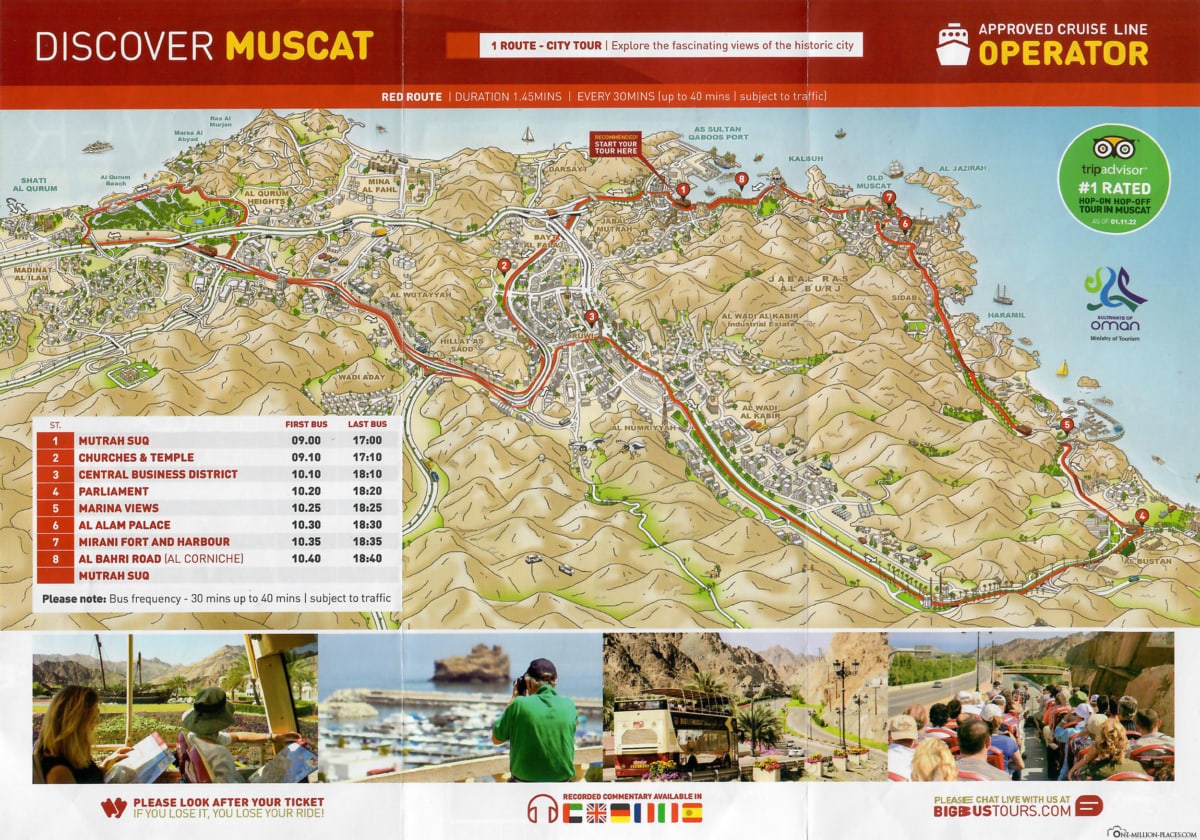After exploring the beautiful fjord landscape and cultural heritage of Khasab on our Mein Schiff cruise the day before, today we headed to the Omani capital of Muscat. The port city is located on the northeast coast of the country on the Gulf of Oman and shines with oriental flair, a rich culture and historic architecture. Since we only had one day to explore the city, we opted for a classic Hop-On Hop-Off tour directly from the Cruise Terminal with Big Bus.

Table of contents
Things to know about Muscat (Oman)
Muscat (German spelling: Maskat) is the capital of the Sultanate of Oman and is located on a bay enclosed by cliffs. The actual core city has only about 30,000 inhabitants. Together with its suburbs Matrah, Ruwi, Qurum and Sib, it forms the Muscat Capital Area, which has a total population of about 640,000 and stretches for 50 kilometers along the sea. The surrounding countryside attracts with desert, high mountains and wadis (gorges).
The first settlements on the territory of today’s Muscat existed already in the second millennium BC. With the spread of Islam in Oman and the expulsion of the Persian occupiers, Oman achieved relative independence. From the 7th to the 16th century, many Omani coastal cities therefore developed into important trading centers. In the following years, many invasions followed, which again gave the country a setback and broke through their further development. From 1808 Muscat was able to assert itself as a seat of government, was developed into an important seaport, and towards the end of the 19th century was fortified with a high wall and forts to protect it from invaders.
Since 1971, with the accession of Sultan Qabus to power, Muscat has become the undisputed capital. He had ousted his father shortly before in a coup d’état, and since then he has been responsible for the steady modernization of the hitherto very backward country. In the course of this so-called Omani renaissance, Muscat was also greatly expanded and was able to develop into a modern and dynamic metropolis, i.e. there are now modern hospitals, many secondary schools, shopping malls, hotels according to Western standards, a radio and television station and a stock exchange. Today, Muscat is the economic heart of the country: Here, the port exports the oil that is the mainstay of the Omani economy and accounts for more than 50% of total government revenue. In January 2020, Sultan Qabus died. Since he had no children or siblings, his cousin Haitham ibn Tariq succeeded him as the new sultan.
Cruise ship docking & our mooring time
Berth Muscat: Sultan Qaboos Port, Passenger Cruise Terminal, Pier 1 & 2
Laytime: 8.30 a.m. to 10.30 p.m.
All on board: 22.00
Our cruise ship Mein Schiff 6 has docked at the Passenger Cruise Terminal of Sultan Qaboos Port. There is a small cruise terminal on the site, but you won’t find any tourist infrastructure here. The terminal is rather used only for security checks.
Upon disembarking from the ship, one receives an unpersonalized shore leave card from a local government employee. You have to carry these with you during the entire time and hand them in again as soon as you re-enter the ship. In case of card loss, one has to pay a fee of 5 USD. Due to regulatory requirements, individual entry and exit of the port is not possible. Therefore, free harbor shuttle buses are available directly in front of the ship to take passengers to the harbor exit as part of a regular shuttle service. From there, you can either walk into town within 20 minutes or take a cab for further exploration.
The highlight in the harbor are certainly the two huge and impressive yachts of the Sultan of Oman, which have their permanent anchorage there.
“Hop-On Hop-Off” with Big Bus through Muscat
Since we only had one day to explore the city, we opted for a classic Hop-On Hop-Off tour directly from the Cruise Terminal. Here, the double-decker buses are already waiting right in front of the ship and you can also buy tickets (from 78 USD) for the tours on the spot.
The Big Bus Tours company is the world’s largest provider of sightseeing tours by open-top double-decker buses. Currently, you can go on an urban exploration tour with Big Bus in 24 cities and four continents. In Europe there are 9 cities in the program (Berlin, Budapest, Dublin, Istanbul, London, Munich, Paris, Rome, Vienna), in America there are 8 cities (Chicago, Las Vegas, Los Angeles, Miami, New York, Philadelphia, San Francisco, Washington DC), in the Middle East there are 3 (Abu Dhabi, Dubai, Muscat) and in Asia-Pacific there are tours in 4 cities (Darwin, Hong Kong, Singapore, Sydney).
The advantage of a Big Bus tour is that you can see the main sights of a city in a short time. And you are completely flexible, because there are boarding and disembarking options at every stop, so you can put together your sightseeing program very individually. On the bus you get headphones and can learn interesting things about the city during the ride with the help of recorded commentary – and that too in many different languages.
On days when a cruise ship is in the port of Muscat, the tours are offered from the port, i.e. the start and finish is directly at the ship (first bus departs at 8:15 am). Of course, this is super convenient and we were very pleased.
There is only one route in Muscat, the City Tour, which makes a grand sweep of the city, taking in major sights such as the Matrah neighborhood, Parliament and Al-Alam Palace. What we found a bit of a shame is that the Great Sultan Qabus Mosque is unfortunately not included in the Big Bus tour. A complete lap on the City Tour takes about 1 hour and 45 minutes. There are eight stops where you can get off and on as often as you like. Buses stop on schedule – depending on traffic – approximately every 30 to 40 minutes at each stop.
Here you can download a nice map showing the route and all stops of Big Bus in Muscat.
The top 5 sights in Muscat
As part of our Big Bus tour of Muscat, we saw some of the city’s most beautiful sights and photo spots.
The district of Mutrah
The district of Mutrah is located directly on the sea and has a wide, very well-kept and clean waterfront (Corniche), which was redesigned in 2005 and is ideal for a walk. From here you also have a fantastic view of the harbor with the cruise ships and the two yachts of the Sultan. Along the Corniche we walked to Riyam Park, on the hill of which an observation tower in the shape of a giant white incense burner (Riyam Censer) is installed. We already noticed it when we entered the port of Muscat and it is considered a landmark of Mutrah.
The destination of most tourists in Mutrah is the Souk of Mutrah, which is the largest souk in Oman and offers a very wide selection of Omani handicrafts, clothing, accessories, tableware, spices and souvenirs in its winding alleys. We strolled through here a bit in the afternoon, but no typical souk flair really arose, because there was simply far too little going on. It will probably only get really crowded in the evening hours.
Other sights in Mutrah include the Shiite mosque right on the waterfront, Mutrah Fort, and the fish market near the harbor.
The Great Sultan Qabus Mosque
Unfortunately, we did not see and visit the Great Sultan Qabus Mosque during our city exploration tour. It is the main mosque of Oman, considered one of the most important buildings in the country and one of the largest mosques in the world. It can be visited free of charge from 8:30 a.m. to 11 a.m. Saturdays through Thursdays – unfortunately, we didn’t have time to do that. The mosque is located on an area of over 40,000 m² and was ceremoniously inaugurated and opened in 2001 after a six-year construction period. The white building complex was constructed of 300,000 tons of Indian sandstone and consists of a large men’s prayer hall, a smaller women’s prayer hall, five minarets, two large archways, an Islamic information center, and a library.
The mosque can accommodate a total of up to 20,000 worshippers. The square main prayer room seats 6,500 worshippers and has a central dome that rises 50 meters above the ground. The floor is covered with a one-piece Persian carpet made of millions of knots and weighing 21 tons. The carpet was hand-knotted by Iranian women, who took 27 months to make it. As in other mosques, there are special dress codes for visiting the mosque: Women should cover their arms, legs and hair; men should wear long pants.
The historic Old Muscat
A worthwhile stop is historic Old Muscat, with various government buildings and the beautiful royal Al-Alam Palace, whose construction was commissioned by former Sultan Qabus in the early 1970s. Today, the palace is used exclusively for representative purposes, such as receiving state guests or for National Day celebrations. For these occasions there is a very representative entrance to the palace. Otherwise, the entire area around the palace is car-free and accessible only to pedestrians. Unfortunately, the palace is not open to the public. Nevertheless, due to its colorful facade and mosaics, it is a very beautiful and popular photo motif among tourists.
Al-Alam Palace is framed by Al-Jalali Fort and Al-Mirani Fort, both of which are also used only for state affairs. They date back to the 16th century and were once built by the Portuguese to protect the entrance to the natural harbor.
The Old City is also home to the National Museum Oman, the Diwan of Royal Court, the Omani and French Museum, the Bait Al Zubair Museum, the city’s Mathaib Gate and several mosques. In addition, you have a great view of parts of the old city wall that winds its way up the mountains from the royal palace.
The parliament building
Muscat’s new parliament building was designed as a new landmark for the city and as a seat for the national government. It was completed in 2013 and is unfortunately not open to the public. Nevertheless, we got off here once during our Big Bus Tour to take a closer look at the building and its dimensions. The building complex is really huge: it stands on a 100,000 m² plot of land and the facade of the building is an incredible 5 km long. The centerpiece is the 64-meter clock tower, which is the tallest in Oman.
With its white facade, the parliament building forms a really beautiful photo motif against the background of the red-brown mountain landscape.
The Royal Opera House
We also saw the Royal Opera House during our Big Bus tour, but unfortunately there was no way to get off here. It is located in the Shati al-Qurm district and is one of the first opera houses in the Gulf States. The building was constructed in the modern Omani architectural style of public buildings, which combines elements of different building traditions. After a four-year construction period, the opera house was opened at the beginning of September 2011 during a gala evening with a small circle of guests of honor. By the way, the large concert organ was built by the organ building company Klais from Bonn.
There is also a souvenir store, several catering establishments, some luxury stores and a cultural center with a cabaret stage on the premises.
All travel reports of our cruise with Mein Schiff
On our one-week cruise "Dubai to Oman" with the Mein Schiff 6 from TUI Cruises, we were able to experience five eventful and varied days ashore: Our journey took us from the city of superlatives - Dubai - to Abu Dhabi, where the largest mosque in the United Arab Emirates is located. We continued to the oriental Khasab (Oman) with its breathtaking fjord landscape and to Muscat, the capital of the Sultanate of Oman, which is surrounded by mountains and desert. The last stop of our trip was after a relaxing sea day the island Sir Bani Yas (UAE), which offers a kilometer-long sandy beach and a nature reserve with 10,000 animals. With beautiful memories in our luggage, disembarkation then took place back in Dubai. Crusie Day 1 » Mein Schiff 6 - Check In, Cabin & Discover the Cruise Ship
Crusie Day 1 » Mein Schiff 6 - Check In, Cabin & Discover the Cruise ShipCrusie Day 2 » Abu Dhabi - The Top 5 Sights on Your Own
Crusie Day 3 » Khasab - Boat trip through the fjord world & Khasab Castle
Crusie Day 4 » Muscat - Top 5 Sights & Photo Spots
Crusie Day 5 » Seetag
Crusie Day 6 » Sir Bani Yas (Beach, Safari & Island Tour)
Crusie Day 7 » Dubai (Day on board & Check Out)


